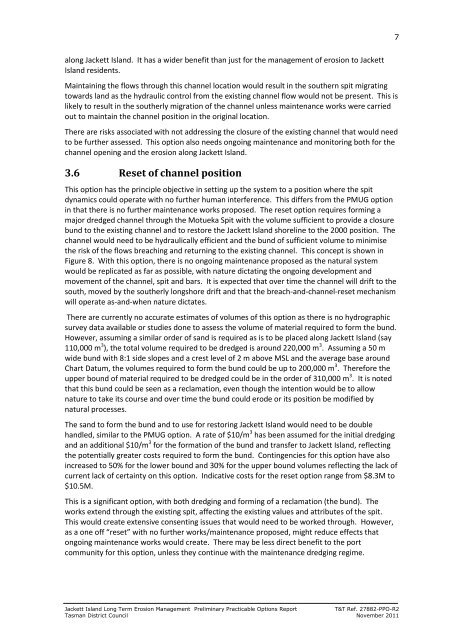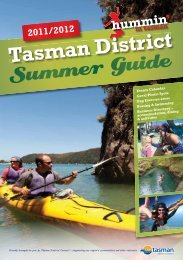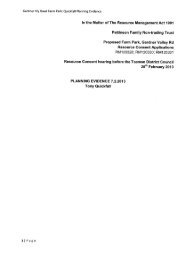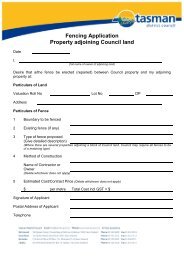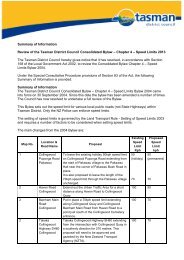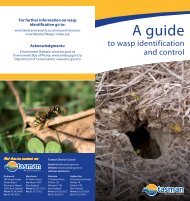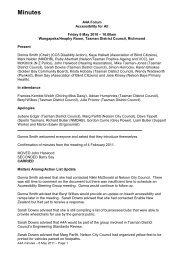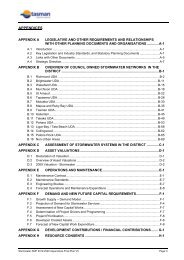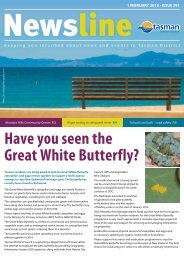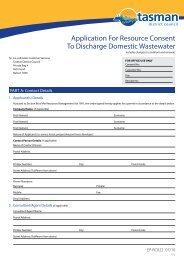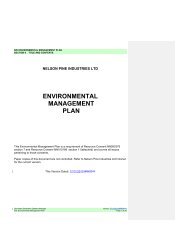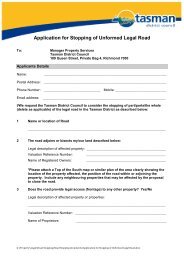RESC11-12-02 Port Motueka Groyne-Jackett Island Erosion ...
RESC11-12-02 Port Motueka Groyne-Jackett Island Erosion ...
RESC11-12-02 Port Motueka Groyne-Jackett Island Erosion ...
Create successful ePaper yourself
Turn your PDF publications into a flip-book with our unique Google optimized e-Paper software.
7<br />
along <strong>Jackett</strong> <strong>Island</strong>. It has a wider benefit than just for the management of erosion to <strong>Jackett</strong><br />
<strong>Island</strong> residents.<br />
Maintaining the flows through this channel location would result in the southern spit migrating<br />
towards land as the hydraulic control from the existing channel flow would not be present. This is<br />
likely to result in the southerly migration of the channel unless maintenance works were carried<br />
out to maintain the channel position in the original location.<br />
There are risks associated with not addressing the closure of the existing channel that would need<br />
to be further assessed. This option also needs ongoing maintenance and monitoring both for the<br />
channel opening and the erosion along <strong>Jackett</strong> <strong>Island</strong>.<br />
3.6 Reset of channel position<br />
This option has the principle objective in setting up the system to a position where the spit<br />
dynamics could operate with no further human interference. This differs from the PMUG option<br />
in that there is no further maintenance works proposed. The reset option requires forming a<br />
major dredged channel through the <strong>Motueka</strong> Spit with the volume sufficient to provide a closure<br />
bund to the existing channel and to restore the <strong>Jackett</strong> <strong>Island</strong> shoreline to the 2000 position. The<br />
channel would need to be hydraulically efficient and the bund of sufficient volume to minimise<br />
the risk of the flows breaching and returning to the existing channel. This concept is shown in<br />
Figure 8. With this option, there is no ongoing maintenance proposed as the natural system<br />
would be replicated as far as possible, with nature dictating the ongoing development and<br />
movement of the channel, spit and bars. It is expected that over time the channel will drift to the<br />
south, moved by the southerly longshore drift and that the breach-and-channel-reset mechanism<br />
will operate as-and-when nature dictates.<br />
There are currently no accurate estimates of volumes of this option as there is no hydrographic<br />
survey data available or studies done to assess the volume of material required to form the bund.<br />
However, assuming a similar order of sand is required as is to be placed along <strong>Jackett</strong> <strong>Island</strong> (say<br />
110,000 m 3 ), the total volume required to be dredged is around 220,000 m 3 . Assuming a 50 m<br />
wide bund with 8:1 side slopes and a crest level of 2 m above MSL and the average base around<br />
Chart Datum, the volumes required to form the bund could be up to 200,000 m 3 . Therefore the<br />
upper bound of material required to be dredged could be in the order of 310,000 m 3 . It is noted<br />
that this bund could be seen as a reclamation, even though the intention would be to allow<br />
nature to take its course and over time the bund could erode or its position be modified by<br />
natural processes.<br />
The sand to form the bund and to use for restoring <strong>Jackett</strong> <strong>Island</strong> would need to be double<br />
handled, similar to the PMUG option. A rate of $10/m 3 has been assumed for the initial dredging<br />
and an additional $10/m 3 for the formation of the bund and transfer to <strong>Jackett</strong> <strong>Island</strong>, reflecting<br />
the potentially greater costs required to form the bund. Contingencies for this option have also<br />
increased to 50% for the lower bound and 30% for the upper bound volumes reflecting the lack of<br />
current lack of certainty on this option. Indicative costs for the reset option range from $8.3M to<br />
$10.5M.<br />
This is a significant option, with both dredging and forming of a reclamation (the bund). The<br />
works extend through the existing spit, affecting the existing values and attributes of the spit.<br />
This would create extensive consenting issues that would need to be worked through. However,<br />
as a one off “reset” with no further works/maintenance proposed, might reduce effects that<br />
ongoing maintenance works would create. There may be less direct benefit to the port<br />
community for this option, unless they continue with the maintenance dredging regime.<br />
<strong>Jackett</strong> <strong>Island</strong> Long Term <strong>Erosion</strong> Management Preliminary Practicable Options Report<br />
T&T Ref. 27882-PPO-R2<br />
Tasman District Council November 2011


